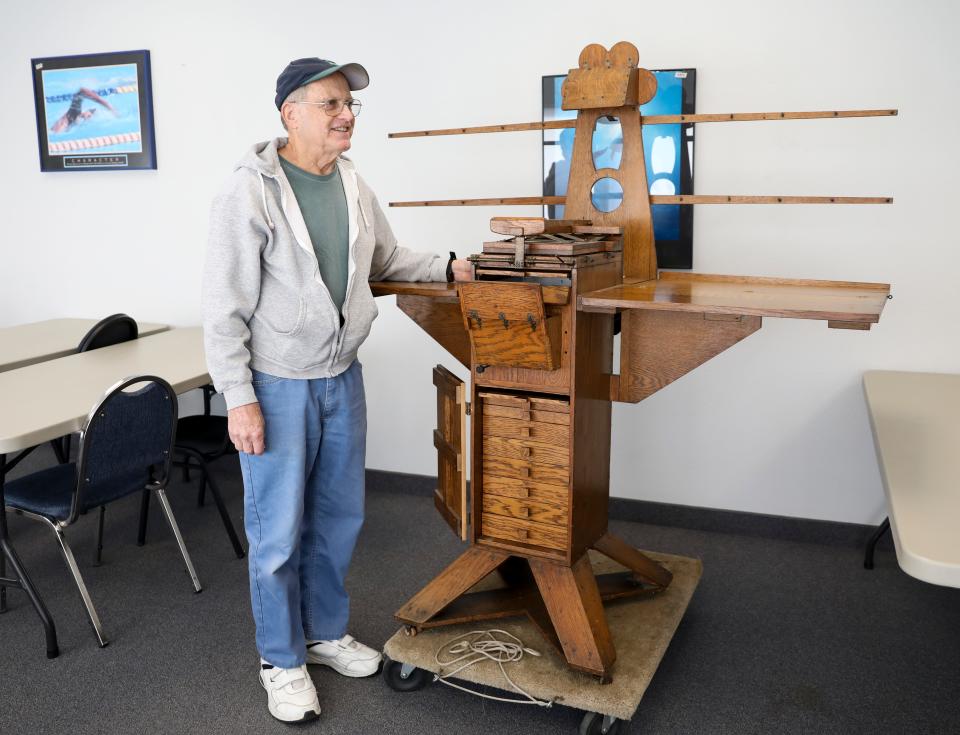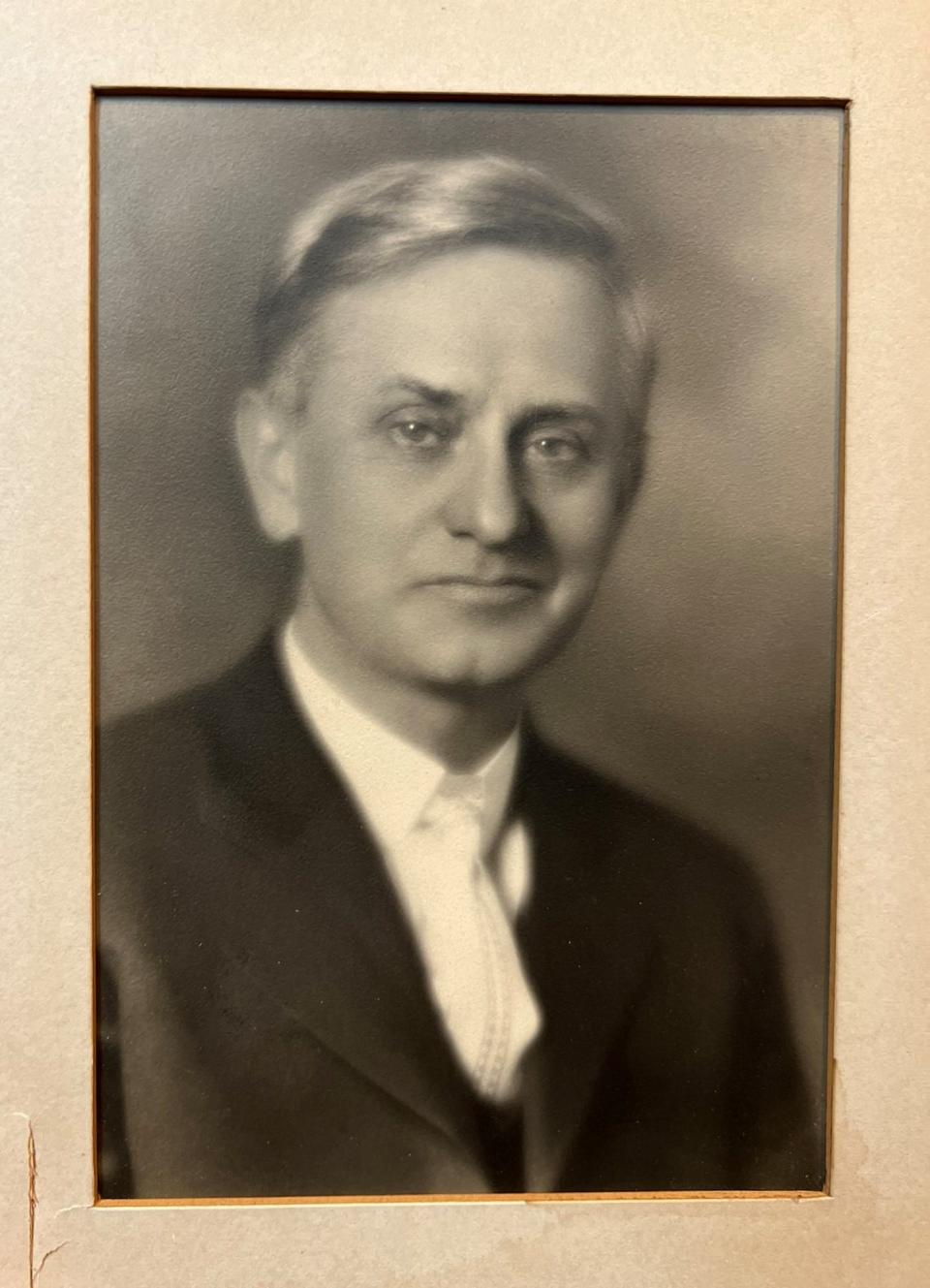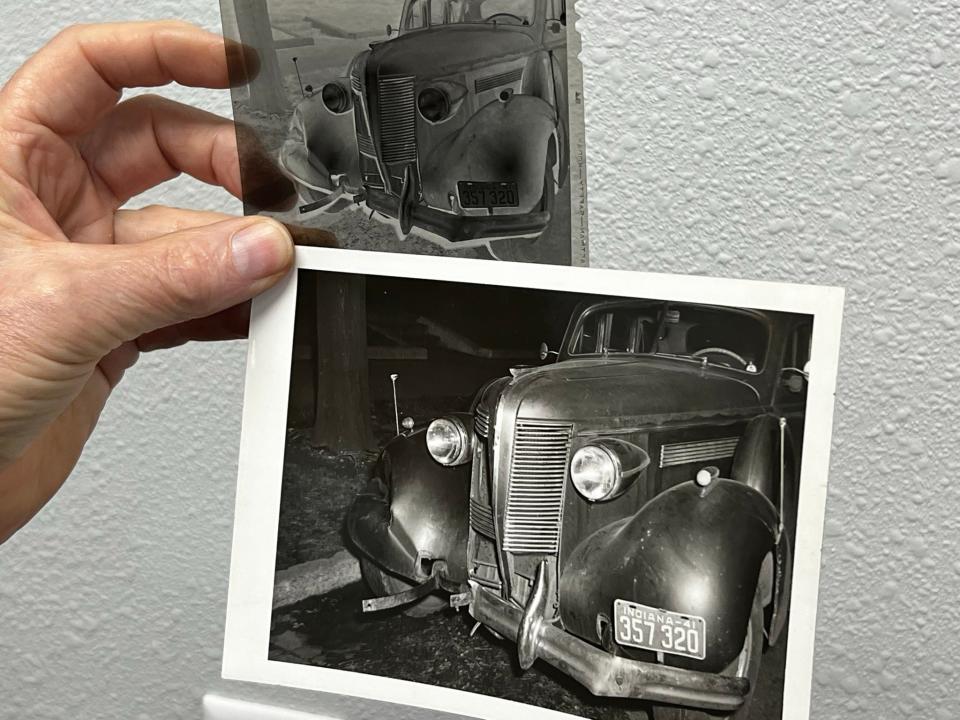Antique photo printer stirs conversation at South Salem Senior Center
The South Salem Senior Center has a rummage sale twice a year featuring donated items such as furniture, clothing, sporting goods, jewelry, appliances and computers.
Proceeds help the nonprofit organization pay for the maintenance and operation of the building.
When something unique is donated, organizers may withhold it from sale until they have researched its historic value.
"We get things like a steamer trunk or an old Singer sewing machine," volunteer Roger Brousseau said. "But this is the coolest."

He is talking about a nearly 100-year-old printing device donated in late August. It is housed in a cabinet with shelves and drawers and looks more like antique furniture than photography equipment.
At the core of the solid oak frame is a contact printer, which prints photographs from film or negative.
"It has become an interesting conversation piece at the center," Brousseau said. "Many people are suggesting putting it in a museum because it is so unique."
How it got here
Guy Atherton Righter, who lived in Richmond, Indiana, built the piece. Three generations of Righter's family have since kept it in pristine condition, sometimes using it as intended, more often displaying it as an heirloom.
A granddaughter and great-grandson, who have both had it in their homes over the years, now live in Salem.
Brousseau is determined to find a new and suitable home for the antique, which Anna Willman appreciates. She is Righter's granddaughter.

Willman brought the contact printer to Oregon when she moved here around 1990. She said it survived past moves between Indiana, Illinois, Maryland and New York.
"It really is a beautiful piece of work, lugged from place to place with me," Willman said. "For a long time, I had it as a conversation piece. It's the only one in the world."
She said her sister also had it for a time. And more recently, her son displayed it in the corner of his dining room before giving it to his in-laws for safekeeping. The in-laws eventually donated it to the senior center.
How it worked
Brousseau, a volunteer at the center for 16 years, researched contact printers and demonstrated how he believes it would have worked.
A print or negative would be placed on the printing glass face up, topped by a sheet of photographic paper, with emulsion sides touching. The hinged-top cover would be closed, pressing the two in close contact and keeping them snugly in place.
Lights under the glass would be turned on for the required exposure time. The photo paper would then be developed with chemicals in a darkroom, resulting in a contact print.

No one knows if the printer still works. The electrical cord on the back of the machine is dated, and the plug is broken. Even if it was intact, the plug is not polarized, which means it might not be safe and may not even work in a modern outlet.
Righter's descendants believe the printer was operational through the 1960s and 1970s, if not longer.
Willman remembers her parents kept it in the basement, where they did all their photography work. Her mother made Christmas cards with photos printed from the machine.
'I don't know if he was famous'
When the contact printer arrived at the senior center, its eight drawers contained boxes of photographic paper and stacks of prints and negatives. Righter made each drawer sealed to prevent exposure of the photo paper. Expiration dates on the boxes range from 1925 to 1954.
Brousseau matched some of the negatives and prints from the drawers, including individual and family portraits and old automobiles.
"With the resolution you see on those pictures," Brousseau said, "it was a good printer."

Willman recognized some of the images, including portraits of her aunt and a portrait of her grandparents and their three children, one of them her mother.
She shared other family photos during a recent visit to her home, including one of her grandfather and of her mother and siblings when they were young.
Willman said her grandfather was a printer by trade and a photographer and cabinet maker by choice. He was known to the family as an intelligent, self-educated man who didn't much care for the printing trade but did it well.
"I don't know if he was famous for anything," Willman said. "If he had gone to college, he may have been. That was a lifelong regret. He always felt inferior because he couldn't go to college."
She also described him as an inventor. Her family still treasures the three-story miniature toy factory he built with working levers and pullies.

An online search revealed her grandfather could have been more famous than she thought.
A patent was filed by him in 1899 for the design of a carpet stretcher. Volume 87 of the Official Gazette of the United States Patent Office lists the patent with a rudimentary sketch of a broom-type device.
He is included in a database of Indiana authors from 1917-1966. The book "Mixing Printer's Metals" by Guy Atherton Righter was published in 1908 when he would have been about 32.
The entry says Righter moved to Indiana in 1913 and worked for the Richmond Item. The newspaper merged with the Palladium in 1939. Righter was made mechanical superintendent of the Palladium-Item and became foreman of the composing room before retiring in 1944.
He would have worked in the industry at a time when printing a newspaper was a more laborious process. Blocks of type made from molten metal would have been used to create the layout on a page.
Willman was just a toddler when he retired and about 11 when he died in 1953. Righter was 77 when he died.
Preserving the antique
The cabinet Willman's grandfather made looks well cared for, the oak finish pristine.
"We sure have tried," she said, "movers notwithstanding."
She said everything is just as her grandfather built it, except for the wheels. The original hand-carved wooden wheels were a casualty during one of the moves.
Brousseau said he was impressed by the quality of craftsmanship of the cabinet, which measures about 5 feet wide and 6 feet tall. Even as large as it is, Righter built it to be portable. The side wings for the workspace fold over and down. So do the back arms for hanging film strips and prints. Everything collapses into a two-foot-wide frame on wheels.
“This guy decided it would be professional the way he built it in every way,” Brousseau said.

For now, the piece sits in the back of a meeting room at the senior center. Brousseau wants to share it with the public, perhaps at a museum or other historical space where it can be displayed and preserved.
"People need to see this thing," he said.
A couple of visitors to the senior center expressed interest in buying the contact printer early on but backed out. Brousseau made it clear he would not sell it for cheap.
"There's no way to put a price on it," he said.
Capi Lynn is the Statesman Journal's news columnist. Send comments, questions and tips to her at clynn@statesmanjournal.com or 503-399-6710. Follow her work on Twitter @CapiLynn and Facebook @CapiLynnSJ.
This article originally appeared on Salem Statesman Journal: Antique photo printer stirs conversation at Salem senior center

